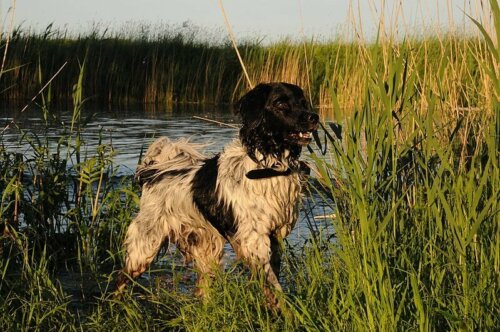Three Tips to Prevent Leptospirosis in Pets


Written and verified by the vet Juan Pedro Vazquez Espeso
When you go to the vet to update your pet’s routine vaccinations, you’re sure to have heard them mentioning leptospirosis. This disease has zoonotic potential. In other words, it is transmissible to humans. As a result, it’s included in all vaccination schedules. This is important, considering that it is one of the most widespread zoonosis diseases worldwide. In this article, we’ll talk about tips to prevent leptospirosis in pets.
Leptospirosis in pets and the environment
In order to prevent diseases, it’s important to know about their relationship with the environment. If you don’t know how causal agents develop in the environment, it’s hard to prevent effectively. Therefore, we’re going to briefly discuss the relationship of this bacterium with the environment.

One of the most favorable environments for the causative agent of leptospirosis is stagnant waters and mudflats. Be careful where you let your dog swim!
Leptospirosis in pets is a disease caused by a bacteria called Leptospira app. In fact, within this genus, there are several pathogenic species that cause the disease.
As for pets, this disease can affect dogs, cats, rats, and even hedgehogs. However, in hedgehogs, it’s not usually part of a routine differential diagnosis due to their habits.
The disease is transmitted through direct contact with an infected animal or indirectly through secretions.
- Direct contact: This includes sexual contagion, although it’s more frequent from male to female through semen. It also can transmit through infected fetuses or placental remains.
- Indirect contact: If there’s an exposure of the bacteria to favorable environments, the bacteria can survive. For example, if an infected animal eliminates the bacteria, it can remain in the environment in an infectious capacity.
Where can pets get leptospirosis?
The characteristics of a favorable environment for the survival of these bacteria are the following:
- A warm climate of between 50 and 90 degrees Fahrenheit. The bacteria can’t withstand extreme temperatures.
- Another essential environmental condition is humidity. They require humid environments with stagnant water sources or swampy terrain. For example, in circulating waters it’s is much more difficult for them to survive and reproduce.
- Another logical factor is the density of the animal population. As we’ve already seen, they are bacteria that infected animals excrete. This means that, no matter how much stagnant and warm water there is, it’ll never be contaminated by leptospires until a sick animal urinates in the water, for example.
Tips to prevent leptospirosis in pets
Now that we understand a little better how this bacterium works, it’s easier for us to understand the mechanisms involved in preventing it.
Vaccination
Of course, the main and most effective measure for preventing this disease and many other diseases is vaccines. The vaccine for canine leptospirosis is generally a required vaccine. This is because dogs are the most susceptible to contracting this disease.
While there are certain standardized rules regarding the vaccination schedule, each vet has some freedom to follow their own criteria. However, most vets recommend that this vaccination is administered at least once a year. This is because the post-vaccination immunity only lasts for around 10 months.
In high-risk animals, such as hunting dogs or sheepdogs, vets recommend vaccinating at least every 6 months.
This is especially important in areas where there are favorable conditions for the disease, such as temperate and humid climates. For example, if you live in a desert area, you don’t need to worry too much about this disease.

Control in communities
People should take special care in areas where there’s a high density of animals, such as shelters, kennels, or homes where there are lots of animals in a small space.
It’s important to be very careful and maintain hygienic standards in these environments. You should clean frequently to avoid a sick animal’s excretion with bacteria being within reach of other animals. Also, using rocks or another type of terrain can help prevent them from touching puddles or standing water.
Of course, any sick animals should be isolated from other animals. Also, due to this disease’s zoonotic potential, owners should handle infected pets and their secretions with great care, especially urine.
Rodent control
Rodents, such as rats and mice, have proven to be an important vector in leptospirosis. Due to their curious nature, they’re able to get into almost any environment. And, there, they run the risk of contamination through their urine.
As we’ve seen, leptospira is a bacterium that easily survives and reproduces in many geographical areas. Due to its zoonotic potential, it’s important that you do your bit to prevent the spread of this disease.
When you go to the vet to update your pet’s routine vaccinations, you’re sure to have heard them mentioning leptospirosis. This disease has zoonotic potential. In other words, it is transmissible to humans. As a result, it’s included in all vaccination schedules. This is important, considering that it is one of the most widespread zoonosis diseases worldwide. In this article, we’ll talk about tips to prevent leptospirosis in pets.
Leptospirosis in pets and the environment
In order to prevent diseases, it’s important to know about their relationship with the environment. If you don’t know how causal agents develop in the environment, it’s hard to prevent effectively. Therefore, we’re going to briefly discuss the relationship of this bacterium with the environment.

One of the most favorable environments for the causative agent of leptospirosis is stagnant waters and mudflats. Be careful where you let your dog swim!
Leptospirosis in pets is a disease caused by a bacteria called Leptospira app. In fact, within this genus, there are several pathogenic species that cause the disease.
As for pets, this disease can affect dogs, cats, rats, and even hedgehogs. However, in hedgehogs, it’s not usually part of a routine differential diagnosis due to their habits.
The disease is transmitted through direct contact with an infected animal or indirectly through secretions.
- Direct contact: This includes sexual contagion, although it’s more frequent from male to female through semen. It also can transmit through infected fetuses or placental remains.
- Indirect contact: If there’s an exposure of the bacteria to favorable environments, the bacteria can survive. For example, if an infected animal eliminates the bacteria, it can remain in the environment in an infectious capacity.
Where can pets get leptospirosis?
The characteristics of a favorable environment for the survival of these bacteria are the following:
- A warm climate of between 50 and 90 degrees Fahrenheit. The bacteria can’t withstand extreme temperatures.
- Another essential environmental condition is humidity. They require humid environments with stagnant water sources or swampy terrain. For example, in circulating waters it’s is much more difficult for them to survive and reproduce.
- Another logical factor is the density of the animal population. As we’ve already seen, they are bacteria that infected animals excrete. This means that, no matter how much stagnant and warm water there is, it’ll never be contaminated by leptospires until a sick animal urinates in the water, for example.
Tips to prevent leptospirosis in pets
Now that we understand a little better how this bacterium works, it’s easier for us to understand the mechanisms involved in preventing it.
Vaccination
Of course, the main and most effective measure for preventing this disease and many other diseases is vaccines. The vaccine for canine leptospirosis is generally a required vaccine. This is because dogs are the most susceptible to contracting this disease.
While there are certain standardized rules regarding the vaccination schedule, each vet has some freedom to follow their own criteria. However, most vets recommend that this vaccination is administered at least once a year. This is because the post-vaccination immunity only lasts for around 10 months.
In high-risk animals, such as hunting dogs or sheepdogs, vets recommend vaccinating at least every 6 months.
This is especially important in areas where there are favorable conditions for the disease, such as temperate and humid climates. For example, if you live in a desert area, you don’t need to worry too much about this disease.

Control in communities
People should take special care in areas where there’s a high density of animals, such as shelters, kennels, or homes where there are lots of animals in a small space.
It’s important to be very careful and maintain hygienic standards in these environments. You should clean frequently to avoid a sick animal’s excretion with bacteria being within reach of other animals. Also, using rocks or another type of terrain can help prevent them from touching puddles or standing water.
Of course, any sick animals should be isolated from other animals. Also, due to this disease’s zoonotic potential, owners should handle infected pets and their secretions with great care, especially urine.
Rodent control
Rodents, such as rats and mice, have proven to be an important vector in leptospirosis. Due to their curious nature, they’re able to get into almost any environment. And, there, they run the risk of contamination through their urine.
As we’ve seen, leptospira is a bacterium that easily survives and reproduces in many geographical areas. Due to its zoonotic potential, it’s important that you do your bit to prevent the spread of this disease.
This text is provided for informational purposes only and does not replace consultation with a professional. If in doubt, consult your specialist.








